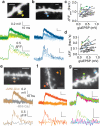An optimized fluorescent probe for visualizing glutamate neurotransmission
- PMID: 23314171
- PMCID: PMC4469972
- DOI: 10.1038/nmeth.2333
An optimized fluorescent probe for visualizing glutamate neurotransmission
Abstract
We describe an intensity-based glutamate-sensing fluorescent reporter (iGluSnFR) with signal-to-noise ratio and kinetics appropriate for in vivo imaging. We engineered iGluSnFR in vitro to maximize its fluorescence change, and we validated its utility for visualizing glutamate release by neurons and astrocytes in increasingly intact neurological systems. In hippocampal culture, iGluSnFR detected single field stimulus-evoked glutamate release events. In pyramidal neurons in acute brain slices, glutamate uncaging at single spines showed that iGluSnFR responds robustly and specifically to glutamate in situ, and responses correlate with voltage changes. In mouse retina, iGluSnFR-expressing neurons showed intact light-evoked excitatory currents, and the sensor revealed tonic glutamate signaling in response to light stimuli. In worms, glutamate signals preceded and predicted postsynaptic calcium transients. In zebrafish, iGluSnFR revealed spatial organization of direction-selective synaptic activity in the optic tectum. Finally, in mouse forelimb motor cortex, iGluSnFR expression in layer V pyramidal neurons revealed task-dependent single-spine activity during running.
Figures






References
-
- Kullmann DM, Asztely F. Trends Neurosci. 1998;21:8–14. - PubMed
-
- Haydon PG. Nat Rev Neurosci. 2001;2:185–193. - PubMed
-
- Nedergaard M, Ransom B, Goldman SA. Trends Neurosci. 2003;26:523–530. - PubMed
-
- Choi DW. J Neurobiol. 1992;23:1261–1276. - PubMed
-
- Parsons CG, Danysz W, Quack G. Drug News Perspect. 1998;11:523–569. - PubMed
Publication types
MeSH terms
Substances
Grants and funding
LinkOut - more resources
Full Text Sources
Other Literature Sources
Molecular Biology Databases
Research Materials

